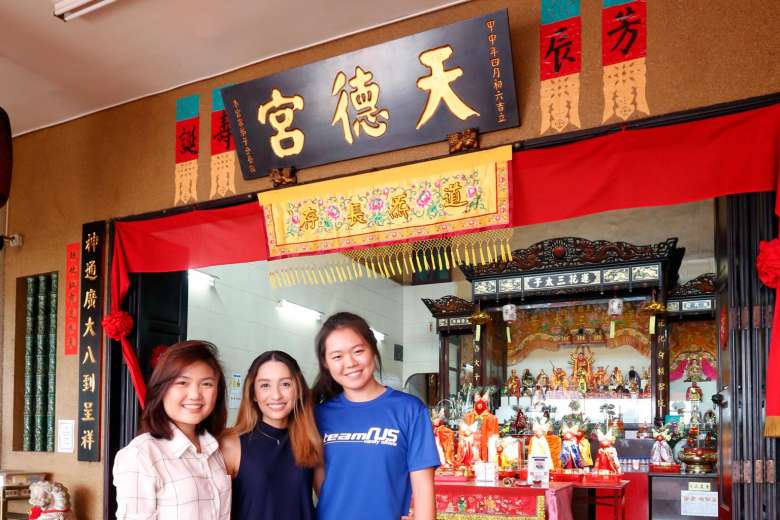NUS-led crowdsourcing project to map over 1,000 Chinese temples here
May 8, 2017
Source:The Straits Times MAY 8, 2017, 5:00 AM SGT
Melody Zaccheus/ Heritage and Community Correspondent

NUS undergraduates (from left) Li Huimin, Sheikha Shamerah and Jasmine Yee, all aged 21, at the Tian Teck Keng temple in Tampines. They were part of a group which helped to document the Chinese temple. ST PHOTO: CHEW SENG KIM
An interactive atlas of more than 1,000 Chinese temples here, dating back to the 19th century, is being developed in the first such project here to consolidate such data.
Led by the National University of Singapore's (NUS) Department of Chinese Studies and using a crowd-sourcing model, the project's success hinges largely on contributions from the public.
However, the geographic information system's (GIS) first contributors are NUS undergraduates who studied 69 temples as part of a module called Everyday Life Of Chinese Singaporeans: Past and Present. These include Tampines' Tian Teck Keng temple, which has the three-headed, six-armed Third Prince Nezha as its main deity. It can trace its roots to the Balestier area, where the deity was housed in the homes of village heads. A permanent place was built for the deity in the form of a wooden shack in 1922.
The group, including 21-year-old undergraduate Jasmine Yee, traced the temple's history and documented its present-day design, layout and sculptures.
NUS Department of Chinese Studies' head Kenneth Dean is leading the project, with the aid of senior research fellow Hue Guan Thye and the NUS Geography Department.
The project, officially called A Singapore Historical GIS Analysis: The transformation Of Chinese Institutions, has received about $700,000 in funding from the Ministry of Education. The map also charts the historical and ongoing movement and relocations of Singapore's 1,000 or so Chinese temples.
Professor Dean said the project's objective is to trace how the country has also been built from the ground up by cultural and religious institutions, and not just through top-down government policies.
By the year end, he and Dr Hue will launch a free mobile application that the NUS Electrical and Computer Engineering Department helped to develop. With it, members of the public can upload photos of temples they patronise, according to categories such as main hall, courtyard and artefacts. They can also submit information such as the year of founding, addresses over the decades, number of members, processions it hosts, and whether it is linked to a "mother temple" in China.
For the past six years, Dr Hue and Prof Dean have been pounding the streets to document inscriptions carved on stone and wooden tablets across 63 Buddhist and Taoist temples, clans and guild houses. Their research is featured in a two-volume book titled Chinese Epigraphy In Singapore, 1819-1911, and is being worked into the map.
Prof Dean is also developing similar maps and apps for clan associations, kampungs, mosques, Indian temples and churches as part of the NUS' cultural mapping project.
Prof Dean said: "The real lives of Singaporeans take place in many of these institutions. The project aims to capture the history that is no longer visible on the rewritten surface of Singapore, but that is buried in people's personal memories and archives of these institutions, to tell a much broader and richer story. "If the material can be more accessible, then I think the past will not disappear so easily."
Ms Yee said the project attempts to capture the history and stories of a variety of temples beyond the more famous ones like the Thian Hock Keng temple in Telok Ayer.
She said: "There is valuable cultural knowledge that we can learn from such places, be it by talking to the helpers or observing the rituals they conduct." The map can be found at http://shgis.nus.edu.sg/index.php/chinese-temples

